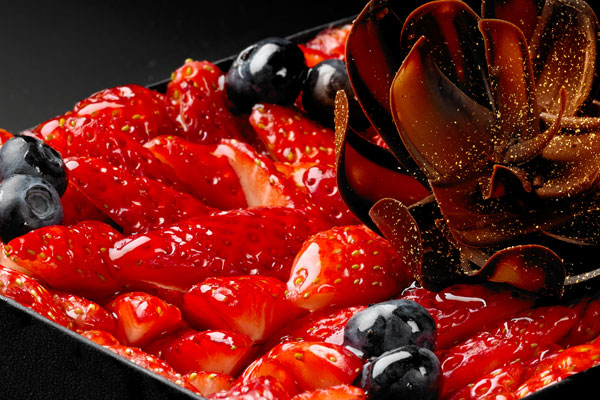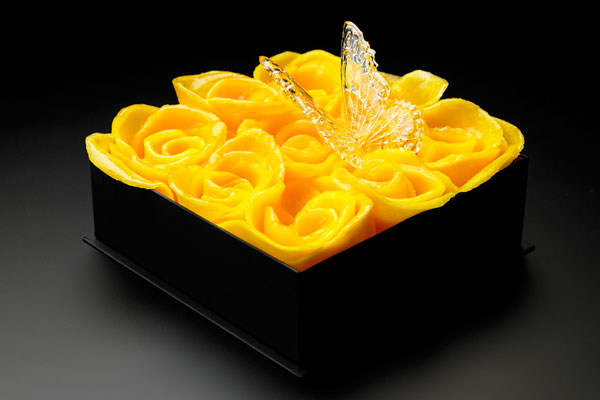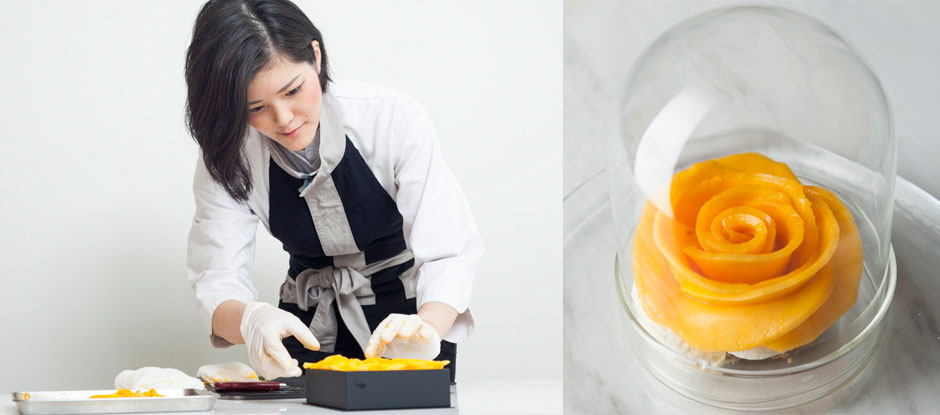In the latest in the Igniting Passion series, presented by elit™ Vodka, we get to know the maker of Tokyo’s most sought-after pastries, Natsuko Shoji of Eté.
“My mom always liked fashion, and that has had a huge influence on me,” begins Natsuko Shoji, the Tokyo-based chef revered for her elegant, fashion-inspired, fruit-topped cakes, sold in limited numbers to those with a connection to the chef. “I love fashion too, that is how Eté’s cakes were born,” she says of her sought-after sweets brand, which also serves as the moniker for her one table, French-inspired tasting menu boîte in Shibuya.
Shoji only opens lunch and dinner reservations to people she knows, or friends of friends (a style of introduction-only dining popular in Japan), and even then she only cooks for around 10 parties per month, up to four guests per seating – the maximum her cosy space can accommodate.
At just 29 years of age, the pastry chef has quickly risen in Japan’s almost entirely male-dominated culinary industry, and along the way she has carved a unique path for herself through tireless work.
“When I was in high school, my favourite subject was home economics,” says the chef, explaining that an early assignment making cream puffs kickstarted her sweet and savoury cooking career. “I got very interested in baking, then I made a lot of cream puffs for my friends… it was such a wonderful way to make something for people who are important to me.”
Shortly after high school, showing early talent, Shoji nabbed a position at Florilège, Tokyo’s progressive French-rooted haunt that counts two Michelin stars and holds the No.3 spot on the Asia’s 50 Best Restaurants 2018 list. Shoji spent three years at the restaurant, where chef and owner Hiroyasu Kawate promoted her to sous chef. In 2014, she opened Eté.
One of Shoji's strawberry-topped creations
Since her restaurant and cake brand’s debut, Shoji has cooked and baked for bold-faced names like world-renowned chef Ferran Adrià and soccer star David Beckham, charging anywhere from $150 to $450 for her tasting menu, and $110 to $2,000 per cake, depending on the specific type and size. It’s also worth noting that for a guest to dine at Eté, he or she must first purchase a cake.
While it’s not every day that one spends hundreds of dollars on dessert, Shoji’s price reflects the quality of fruit that crowns her confections, arranged in patterns inspired by iconic designer handbags, like Coco Chanel’s signature quilted matelassé bag, which served as inspiration for her peach cake. Her newest cake titled Ombré – made from Kyoto and Kumamoto chestnuts prized for their texture and flavour – derives its fading chequered pattern from Glenurquhart cheques, a textile used by designers such as Comme des Garçons.
Those who score a cake will note the prize sheathed in a black container reminiscent of a jewelry box, whose design was inspired by Céline’s luggage collection. Meanwhile, the transparent plastic bag protecting that box was inspired by Virgil Abloh’s Off-White collaboration with high-end luggage maker, Rimowa.
But it’s important to revisit the notion of fruit, and to understand the significance it carries in Japanese cuisine. While around the world is common for a meal to conclude with a complicated dessert, the Japanese instead prize a perfect slice of melon or a shiny strawberry at peak ripeness.
A much-sought-after mango cake
And the flavour of Japanese fruit is unlike fruit grown anywhere else in the world. That’s because Japanese growers prune their trees in ways to produce less fruit, but what fruit the tree does grow contains amplified flavour. Indeed, sometimes the flavour will be so powerful that to some the taste may seem artificial. But it’s not, of course. Because there are far fewer pieces of fruit produced, the price for a single item shoots up.
That luxury fruit is precisely what Shoji is after. She sources white Yuki Usagi strawberries from Saga, red Sakura Momo strawberries from Tokushima, and prized white Shimizu Hakutou peaches from Okayama. Naturally, seasonality affects her ability to find certain types of fruit, and while she orders mangoes from Thailand during Japan’s winter, when the country heats up, she sources the Hakugin-no-Taiyo brand from Hokkaido.
Shoji’s mango cake has become somewhat of a calling card, and it also happens to be the first ever cake she created, made from a sablé cookie base, custard, and petals of mango shaped to look like roses. A similar formula is found in all her cakes: that sablé cookie base layered with custard, mascarpone, or chocolate cream, depending on the featured seasonal fruit, topped with fruit, organized into various patterns. The only problem is securing one.
Asia's 50 Best Restaurants 2019 will be revealed at an awards ceremony in Macao on Tuesday 26th March. Discover the line-up for #50BestTalks on Monday 25th March and follow 50 Best on Instagram, YouTube, Facebook and Twitter for more news, interviews, photos and videos.

